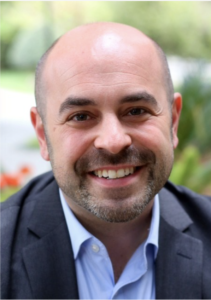 As a FUSE Executive Fellow, Jeremy M. Goldberg (2012-13) worked with the San Jose Office of the Mayor to develop the Silicon Valley Talent Partnership, the city’s first public-private partnership enlisting pro-bono talent from local companies to make public services more effective for residents. Since the conclusion of his fellowship, he has gone on to hold leadership roles in two city governments and the state of New York and served as a strategic consultant to the city of New Orleans. Recently, he became the Worldwide Public Sector Director of Critical Infrastructure at Microsoft.
In his new role, Jeremy brings Microsoft’s partnership and technology resources to bear on efforts to modernize state-owned utilities, enable the next generation of intelligent public transportation, and enhance back-office functions, in order to deliver transparent, convenient, and trusted public services in cities. “Our work ahead is to understand the problems that governments face in critical infrastructure, and from there solve problems in order to meet the needs of residents seeking information and services.” said Jeremy.
As a FUSE Executive Fellow, Jeremy M. Goldberg (2012-13) worked with the San Jose Office of the Mayor to develop the Silicon Valley Talent Partnership, the city’s first public-private partnership enlisting pro-bono talent from local companies to make public services more effective for residents. Since the conclusion of his fellowship, he has gone on to hold leadership roles in two city governments and the state of New York and served as a strategic consultant to the city of New Orleans. Recently, he became the Worldwide Public Sector Director of Critical Infrastructure at Microsoft.
In his new role, Jeremy brings Microsoft’s partnership and technology resources to bear on efforts to modernize state-owned utilities, enable the next generation of intelligent public transportation, and enhance back-office functions, in order to deliver transparent, convenient, and trusted public services in cities. “Our work ahead is to understand the problems that governments face in critical infrastructure, and from there solve problems in order to meet the needs of residents seeking information and services.” said Jeremy.


Transforming Critical Infrastructure at the National, State, and Local Levels
April 30, 2021  As a FUSE Executive Fellow, Jeremy M. Goldberg (2012-13) worked with the San Jose Office of the Mayor to develop the Silicon Valley Talent Partnership, the city’s first public-private partnership enlisting pro-bono talent from local companies to make public services more effective for residents. Since the conclusion of his fellowship, he has gone on to hold leadership roles in two city governments and the state of New York and served as a strategic consultant to the city of New Orleans. Recently, he became the Worldwide Public Sector Director of Critical Infrastructure at Microsoft.
In his new role, Jeremy brings Microsoft’s partnership and technology resources to bear on efforts to modernize state-owned utilities, enable the next generation of intelligent public transportation, and enhance back-office functions, in order to deliver transparent, convenient, and trusted public services in cities. “Our work ahead is to understand the problems that governments face in critical infrastructure, and from there solve problems in order to meet the needs of residents seeking information and services.” said Jeremy.
As a FUSE Executive Fellow, Jeremy M. Goldberg (2012-13) worked with the San Jose Office of the Mayor to develop the Silicon Valley Talent Partnership, the city’s first public-private partnership enlisting pro-bono talent from local companies to make public services more effective for residents. Since the conclusion of his fellowship, he has gone on to hold leadership roles in two city governments and the state of New York and served as a strategic consultant to the city of New Orleans. Recently, he became the Worldwide Public Sector Director of Critical Infrastructure at Microsoft.
In his new role, Jeremy brings Microsoft’s partnership and technology resources to bear on efforts to modernize state-owned utilities, enable the next generation of intelligent public transportation, and enhance back-office functions, in order to deliver transparent, convenient, and trusted public services in cities. “Our work ahead is to understand the problems that governments face in critical infrastructure, and from there solve problems in order to meet the needs of residents seeking information and services.” said Jeremy.
 As a FUSE Executive Fellow, Jeremy M. Goldberg (2012-13) worked with the San Jose Office of the Mayor to develop the Silicon Valley Talent Partnership, the city’s first public-private partnership enlisting pro-bono talent from local companies to make public services more effective for residents. Since the conclusion of his fellowship, he has gone on to hold leadership roles in two city governments and the state of New York and served as a strategic consultant to the city of New Orleans. Recently, he became the Worldwide Public Sector Director of Critical Infrastructure at Microsoft.
In his new role, Jeremy brings Microsoft’s partnership and technology resources to bear on efforts to modernize state-owned utilities, enable the next generation of intelligent public transportation, and enhance back-office functions, in order to deliver transparent, convenient, and trusted public services in cities. “Our work ahead is to understand the problems that governments face in critical infrastructure, and from there solve problems in order to meet the needs of residents seeking information and services.” said Jeremy.
As a FUSE Executive Fellow, Jeremy M. Goldberg (2012-13) worked with the San Jose Office of the Mayor to develop the Silicon Valley Talent Partnership, the city’s first public-private partnership enlisting pro-bono talent from local companies to make public services more effective for residents. Since the conclusion of his fellowship, he has gone on to hold leadership roles in two city governments and the state of New York and served as a strategic consultant to the city of New Orleans. Recently, he became the Worldwide Public Sector Director of Critical Infrastructure at Microsoft.
In his new role, Jeremy brings Microsoft’s partnership and technology resources to bear on efforts to modernize state-owned utilities, enable the next generation of intelligent public transportation, and enhance back-office functions, in order to deliver transparent, convenient, and trusted public services in cities. “Our work ahead is to understand the problems that governments face in critical infrastructure, and from there solve problems in order to meet the needs of residents seeking information and services.” said Jeremy.